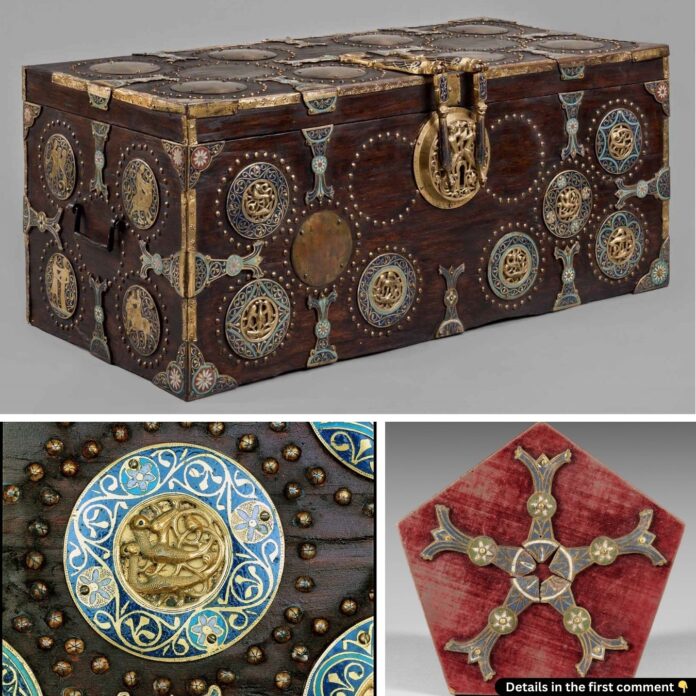The Limoges casket, a masterpiece of medieval craftsmanship, has captivated historians and art enthusiasts for centuries. Recently, five missing enamel brackets from this 13th-century treasure were recovered, shedding new light on its intricate artistry and rich history. This remarkable achievement, made possible by the collective efforts of 742 donors, underscores the enduring significance of cultural preservation. Join us as we explore the fascinating story behind this iconic artifact and its extraordinary journey through time.
A Medieval Marvel: The Limoges Chest
Crafted between 1220 and 1225, the Limoges chest stands as a testament to the artistry of medieval goldsmiths. Made from varnished walnut, it is adorned with champlevé enamel medallions, embossed and pierced gilded copper, and intricate brackets and corners featuring vegetal designs. Each medallion tells a story, with motifs ranging from hunting scenes and chivalric imagery to depictions of peasants and fantastical beasts. The chest’s design showcases not only the skill of the Limoges craftsmen but also the cultural richness of the 13th century.
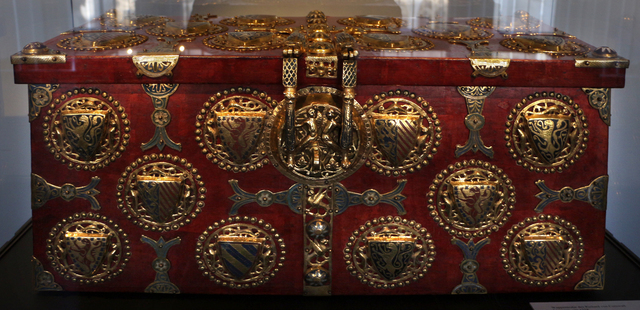
The chest is unique, with only one comparable artifact—the heraldic casket of Richard of Cornwall, housed in Aachen Cathedral. However, the Richard casket, made decades later, lacks the originality and integrity of the Limoges chest, which remains a masterpiece of its time. Originally used to carry valuable liturgical and legal items, the chest belonged to Cardinal Guala Bicchieri, a powerful and influential figure in medieval Europe.
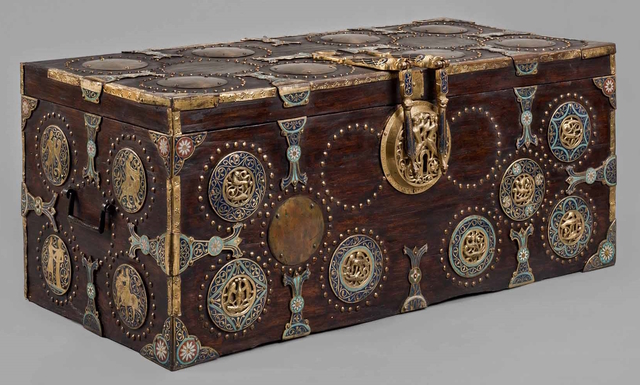
The Life and Legacy of Cardinal Guala Bicchieri
Cardinal Guala Bicchieri’s life was one of diplomacy, power, and devotion. Born around 1160, he served as a papal legate under Popes Innocent III and Honorius III. His most notable achievement was crowning the young King Henry III of England in 1216, a political maneuver that declared the boy king a vassal of the pope, effectively protecting him from rebellious barons. Bicchieri’s seal is even found on the Magna Carta, marking his role in mediating the conflict between the crown and the barons.
Beyond his political achievements, Bicchieri was a patron of art and culture. Over his lifetime, he amassed an extraordinary collection of goldsmith works, illuminated manuscripts, and liturgical items, many of which were stored in the Limoges chest. His influence extended to architecture, with the Gothic-style church of Saint Andrew of Vercelli, which he founded, becoming one of Italy’s earliest examples of Gothic design.
When Bicchieri passed away in 1227, he left his collection, including the chest, to Saint Andrew of Vercelli. Over time, however, the chest fell victim to the tumultuous events of history, losing some of its precious components.
Discover the intricate process of champlevé enamelling – watch the video from the V&A to learn how this ancient technique was mastered and used to create stunning works of art!
The Theft and Rediscovery of the Limoges Chest
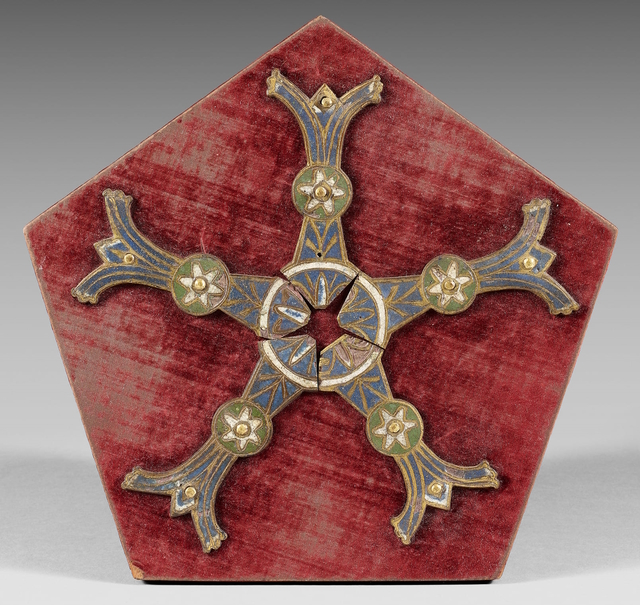
The story of the Limoges chest took a dark turn during the late 18th century, likely during the Napoleonic wars. The enamel brackets adorning its back were removed and eventually disappeared into private collections. The chest itself was hidden, walled up in the presbytery of Saint Andrew, where it remained forgotten until restoration work in 1822 brought it back to light.
In 2004, the city of Turin acquired the chest, placing it in the Civic Museum of Ancient Art. However, the absence of its original brackets left a glaring gap in its completeness. The recent discovery of five missing enamel pieces in a Paris antiques gallery presented a rare opportunity to partially restore this masterpiece to its former glory.
The Crowdfunding Campaign: A Community Effort
When the missing brackets were found, the asking price of €50,000 was a significant challenge for the museum’s budget. Recognizing the importance of the acquisition, the museum launched a crowdfunding campaign in March 2024, calling on art lovers and history enthusiasts to contribute. The response was overwhelming, with 742 donors exceeding the goal by raising €52,145.
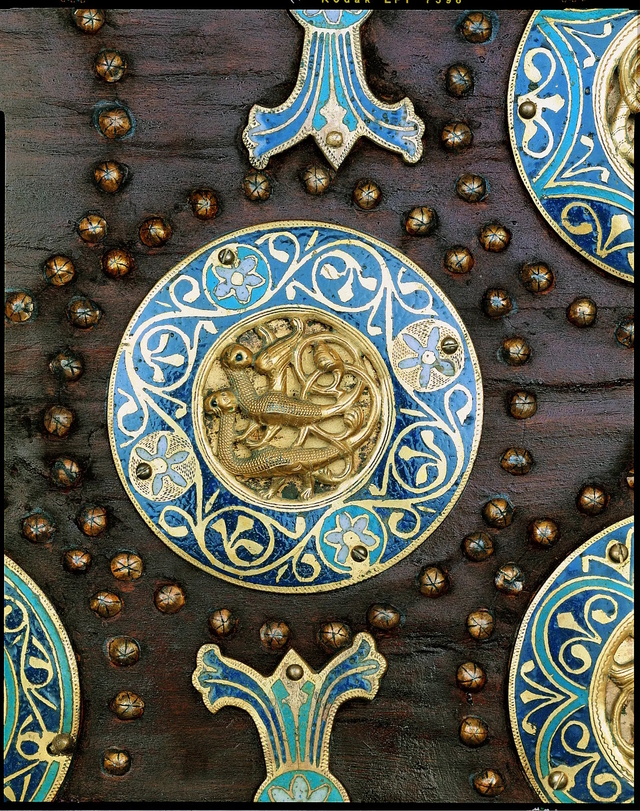
The five enamel brackets, decorated in shades of blue, green, and white, showcase the exceptional craftsmanship of Limoges artisans. They had once adorned the back of the chest, filling the spaces between the larger medallions. Their return not only restores a part of the chest’s original splendor but also underscores the power of collective effort in preserving cultural heritage.
Cultural Significance and Historical Context
The Limoges chest is more than an artifact; it is a window into medieval life and art. The intricate craftsmanship reflects the high standards of 13th-century goldsmithing, while the motifs provide insights into the values and aesthetics of the time. The chest’s connection to Cardinal Bicchieri adds a layer of historical importance, linking it to significant events in medieval Europe, such as the crowning of King Henry III and the dissemination of Gothic art in Italy.
The chest also serves as a reminder of the vulnerability of cultural heritage. Its brackets were stolen during a period of political upheaval, illustrating how war and conflict often result in the loss of irreplaceable treasures. The successful reacquisition of these pieces is a triumph for cultural preservation and a testament to the importance of safeguarding history for future generations.
Restoration and Future Prospects
With the enamel brackets now back in Turin, plans are underway to restore the chest. This restoration will not only enhance its visual and historical integrity but also provide an opportunity for further study and public appreciation. The chest’s journey—from its creation in Limoges to its use by Cardinal Bicchieri, its theft and rediscovery, and its partial restoration—offers a compelling narrative that continues to captivate scholars and art enthusiasts alike.
The museum’s efforts also highlight the importance of community involvement in preserving cultural heritage. The success of the crowdfunding campaign demonstrates that individuals, united by a shared appreciation for history and art, can make a significant impact.
Conclusion
The return of the Limoges enamel brackets is a moment of celebration for the Civic Museum of Ancient Art and for all who value the preservation of cultural heritage. The restored chest stands as a symbol of medieval artistry, the legacy of Cardinal Guala Bicchieri, and the enduring power of collective effort. As it regains its place in history, the Limoges chest continues to inspire and educate, ensuring that the stories of the past remain vibrant and accessible for generations to come.
